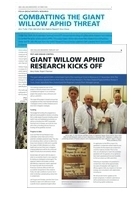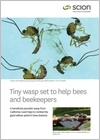Publications
Media
Imported insect predator to help bees and willow trees to thrive, Radio New Zealand, 6 December 2019
Giant willow aphids - a sticky invasive nuisance, Our Changing World podcast, 29 November 2018
Taking on the Giant: interview for Country Life, Radio New Zealand, 18 August 2017
Articles/Newsletters - most recent first
Biological control of giant willow aphid recognised, Scion Connections Issue 42, February 2023
Management of GWA newsletter (annually) - GWA 2022 newletter, GWA 2021 newsletter, GWA 2020 newsletter, July 2019, June 2018, July 2017
Biocontrol for willow pest released and FAQs, Scion media release, 14 February 2020
Information sheet: Biological control of giant willow aphid [updated April 2019]
Citizen science saves the day - GWA article in Scion Connections Issue 28, June 2018
Plant and Food Research update May 2018
Plant and Food Research update October 2017
Scion 2016: Two page leaflet on impacts of giant willow aphid and solutions

Sustainable Farming Fund's 1,000 projects and counting booklet - (page 46)
NZ Beekeeper Magazine - October 2016, February 2017
Forest Health News - issues 246, 248, 268, 278, 292
Plant and Food Research article
Video
Female Pauesia laying an egg inside a living giant willow aphid [YouTube]
Scientific publications
Results from 2018 survey: How is giant willow aphid affecting you?
Earlier this year we conducted a survey to help us to quantify the effects that giant willow aphid is having on New Zealand’s beekeeping community. The results varied between regions and individual respondents, however overall it was clear that the giant willow aphid is indeed problematic for beekeepers and is costing the apiculture industry. The results have helped us to identify what practices are currently being used to manage the effects of giant willow aphid, evaluate the merit of biological control as a potential long term solution. Many thanks to those who participated.

